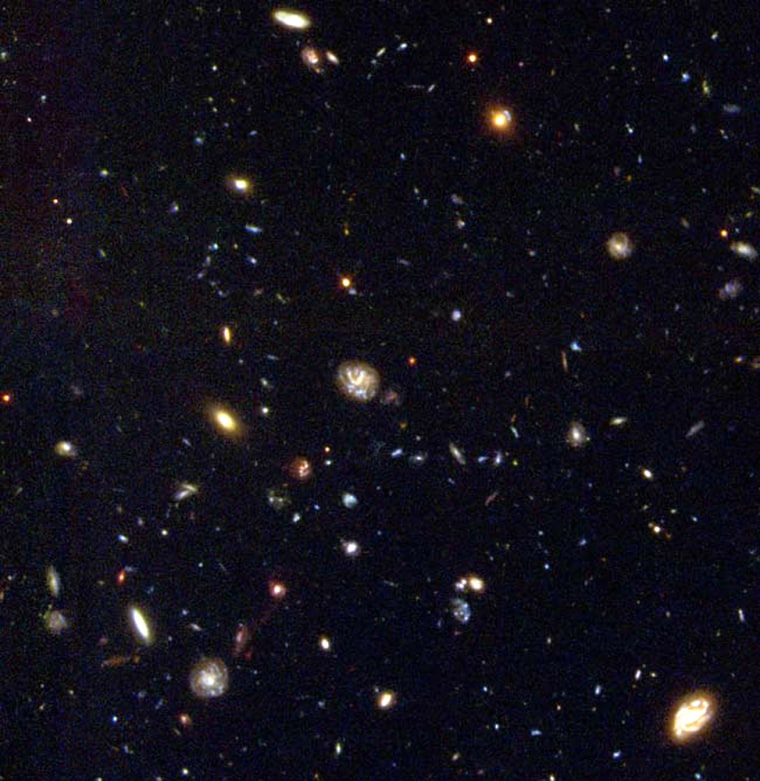New observations reveal that the early universe had its own version of rock-and-roll stars – galaxies that grew fast and died young. What killed these up-and-comers is not yet known.
Using the Spitzer Space Telescope, Ivo Labbé of Carnegie Observatories and his colleagues studied about a dozen massive galaxies shining two billion years after the Big Bang – when the universe was less than a fifth of its present age.
The galaxies, which typically had about 100 billion stars, constitute a variety of different types: some forming new stars, some clouded by dust, and some quite dead in terms of their ability to make new stars.
"It's becoming more and more clear that the young universe was a big zoo with animals of all sorts," said Labbé, lead author of the study. "There's as much variety in the early universe as we see around us today."
The most surprising of these animals are the dead galaxies that literally ran out of gas – or at least cold gas – for making new stars. These giants suffocated far sooner than expected.
"We are really amazed – these are the earliest, oldest galaxies found to date," Labbé said. "Their existence was not predicted by theory and it pushes back the formation epoch of some of the most massive galaxies we see today."
There are observations of even earlier galaxies – from less than a billion years after the Big Bang, but the data are not good enough to tell what exactly was going on inside them, said co-author Jiasheng Huang of the Harvard-Smithsonian Center for Astrophysics.
Color-coding
Astronomers can tell the "liveliness" of a galaxy by its color. Galaxies with ongoing star formation are bluer because of the hot massive stars that shine the brightest. Older galaxies appear redder because massive stars burn out first – leaving only the smaller, cooler stars.
"The current theory would say that most [early] galaxies would be blue," Huang told Space.com in a telephone interview.
This is why Huang and his colleagues were interested in looking at red galaxies seen in the Hubble Deep Field South – one of the space telescope’s penetrating views into the early universe.
Besides early retirement, these Hubble-detected galaxies could appear red because they are full of dust, which absorbs blue light more than red. With Spitzer’s infrared camera, Labbé and his team determined that 75 percent of the red galaxies were indeed dusty.
The rest, though, had stopped forming new stars for about a billion years. Labbé said that it is rare for galaxies to go that long without any star formation.
"Galaxies form stars," he said. "That is what they do."
Galaxy killers
According to Labbé, no one is certain how these early galaxies petered out. They could be so massive that the gas inside became too hot to collapse into new stars. But this galaxy death is thought to happen when the universe is much older.
Labbé thinks a more plausible mechanism is that a super-massive black hole in the center of these dead galaxies is swallowing up gas and spewing out jets and radiation in a way that disrupts star formation in the rest of the galaxy.
Such violent super-massive black holes are typically seen as bright quasars, or more generally active galactic nuclei (AGN). The astronomers plan in future observations to look for evidence of AGN in their dead galaxies.
Dead but not gone
Just because these early galaxies are "deceased," it does not mean they disappeared. Their small red stars continued to shine for billions of years. In fact, some of the galaxies around us today must have long ago looked dead. But which ones?
If you started with one of the galaxies seen in this study, and then ran the clock forward 12 billion years to the present day, the galaxy would be more massive and look "even more dead," Huang said. Nowadays, the big and very red (dead) galaxies are the giant ellipticals.
"It is very likely that these dead galaxies evolve into massive giant ellipticals," Labbé said.
But there are more giant ellipticals than there were dead galaxies, so multiple avenues must exist for making giant ellipticals, Labbé explained.
